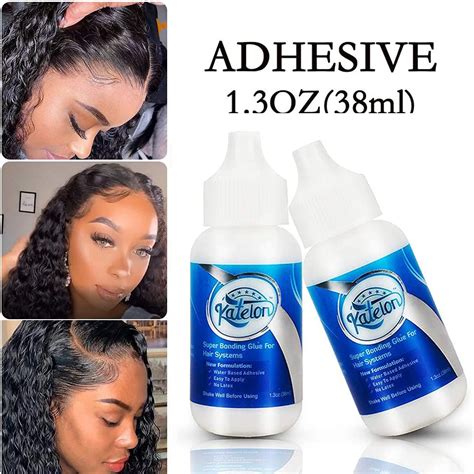Lace wigs are a popular choice for those looking to achieve a natural and undetectable hairline. However, ensuring the wig stays securely in place requires the right adhesive. Lace wig glue provides a strong and long-lasting hold, keeping your wig looking flawless throughout the day.

3 Must-Know Qualities of an Ideal Lace Wig Glue
- Strong Adhesion Strength: The glue should form a firm bond with both your skin and the lace wig, preventing it from slipping or moving.
- Water-Resistant: To withstand sweat, rain, or humidity, the glue should be water-resistant to keep your wig secure in all conditions.
- Gentle on Skin: Avoid irritation and discomfort by choosing a hypoallergenic glue formulated to be gentle on sensitive skin.
Choosing the Right Lace Wig Glue: 4 Essential Factors
1. Skin Type
- Sensitive Skin: Opt for hypoallergenic and low-toxicity glues labeled “sensitive” or “gentle.”
- Normal Skin: Standard glues with average adhesion strength and water resistance will suffice.
- Oily Skin: Choose a strong-hold glue designed to resist excess oil production.
2. Wig Cap Material
- Lace: Regular lace wig glue works effectively on most lace caps.
- Thin Skin: Thin skin caps require specialized thin skin glue for a secure bond without damage.
- HD Lace: HD lace wigs have a more delicate construction, so use a water-based glue or a gentle HD glue.
3. Hold Duration
- Temporary Use (1-2 days): Choose a water-based or low-hold glue that allows for easy removal and daily adjustments.
- Extended Wear (2-4 weeks): Opt for a medical-grade or strong-hold glue that provides a long-lasting and waterproof bond.
- Special Occasions: For special events or activities that involve excessive movement, a high-hold glue is recommended.
4. Removal Ease
- Self-Adhesive: Self-adhesive wigs feature pre-applied glue strips, making removal quick and painless.
- Peel-Off Glue: These water-activated glues form a temporary bond that can be peeled off easily.
- Solvent Glue: Solvent-based glues require a specific remover for safe and effective removal.
Application Techniques for Flawless Adhesion
1. Wig Cap Preparation
- Remove knots, tangles, and any hair products.
- Trim the excess lace around the hairline for a more natural look.
2. Skin Preparation
- Cleanse the area where the wig will be applied with an alcohol-based wipe to remove dirt and oils.
- Allow the skin to dry completely.
3. Glue Application
- Thin Layer: Apply a thin and even layer of glue around the hairline of the wig cap.
- Natural Shape: Shape the glue line to match your natural hairline.
- Avoid Excess: Use a fine-tipped applicator brush or toothpick to prevent clumps or glue build-up.
4. Wig Placement
- Position the wig on the head and press down gently.
- Secure the wig by holding it in place for several minutes until the glue sets.
Troubleshooting Common Mistakes with Lace Wig Glue
1. Insufficient Bond
- Use a stronger glue or apply more glue to ensure a secure hold.
- Check for gaps in the glue line and fill them in to prevent slippage.
2. Glue Adhesive Residue
- Soak a cotton ball in rubbing alcohol and gently dab the glue residue.
- Use a wig glue remover specially formulated for your glue type.
3. Skin Irritation
- Choose a hypoallergenic and skin-friendly glue.
- Do a patch test on a small area of skin before full application.
- Avoid applying glue directly to broken or irritated skin.
4. Premature Bond Failure
- Check the glue expiration date and avoid using old glue.
- Ensure proper surface preparation by cleaning the skin and wig cap thoroughly.
- Allow the glue to dry completely before wig placement.
Tips and Tricks for Invisible and Long-Lasting Results
- Use a hair dryer to set the glue faster and improve its hold.
- Apply a thin layer of baby powder around the hairline to absorb sweat and reduce shine.
- Brush or comb the wig gently to avoid disturbing the glue bond.
- Avoid touching or manipulating the wig excessively, as this can weaken the adhesion.
Innovative Applications Beyond Wig Bonding
The versatility of lace wig glue extends beyond wig attachment. Here are some creative new applications:
1. Tape Extensions
- Replace tape extensions with lace wig glue for a stronger and more invisible bond.
2. Jewelry Repair
- Use lace wig glue to fix loose gemstones or mend broken chains.
3. Fabric Embellishments
- Apply lace wig glue to embellish clothing, bags, or shoes with intricate lace patterns.
4. Craft Projects
- Utilize lace wig glue as an adhesive for paper crafts, scrapbooking, or decorative items.
Conclusion
Choosing the right lace wig glue is crucial for a secure, natural-looking, and long-lasting bond. By understanding the different types, application techniques, and troubleshooting tips, you can achieve flawless wig bonding. Embrace the innovative applications of lace wig glue to discover its versatility beyond wig attachment.
